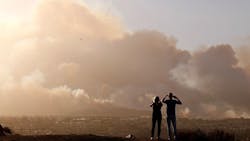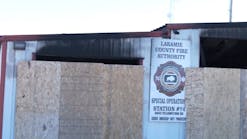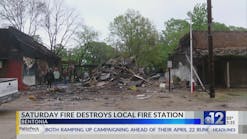Shutdown Hampered CA Wildfire Prevention
By Kurtis Alexander
Source San Francisco Chronicle
President Trump made a commitment last month to reduce wildfire danger across the West, rolling out an ambitious, if uncertain, executive order that demands more aggressive management of the nation’s forests.
The order, which calls for a big boost in logging, grows out of the president’s repeated claims that the deadly fire season in California last year was due to the state’s failure to tame its overgrown woodlands. The week that Trump visited the ruins of the Camp Fire in Butte County, he even threatened to halt disaster funding if the state didn’t “remedy” the situation.
As it turns out, the more immediate risk to forest health and fire prevention is probably not California, but the monthlong shutdown of the federal government.
Even as it came to an end Friday, the president’s impasse with Congress over funding for his border wall hamstrung the nation’s largest land-management agencies long enough to slow Trump’s forest initiative. It also halted vegetation work that fire experts say is even more critical to heading off another bad fire year.
During the shutdown, no new logging projects went forward, nor did fuel reduction programs like brush clearing, controlled fires and slash-pile burns. Also, much of the planning and hiring of firefighters that typically gets done in winter was put on hold. Some federal employees, unauthorized to speak to the media, say fire programs at national parks and forests won’t be fully staffed before the new fire season begins.
“A lot of preparation just didn’t happen,” said Stephen Graydon, a former firefighter for the U.S. Forest Service and now executive director of Terra Fuego, a Butte County organization that works with the government to reduce fire risk. “It’s hard enough to get ahead on large-scale forest treatments. While I can’t give you a number of acres that wasn’t treated during the shutdown, we’ve lost opportunities. The shutdown will have a lasting effect.”
One of Graydon’s latest projects, creating a fire break around the community of Forest Ranch near the Camp Fire, hasn’t been completed because he needed sign-off from the U.S. Bureau of Land Management. The local office was closed during the 35-day shutdown.
“For Trump to come out here and see the devastation and then handcuff people by taking federal agencies out of action, it’s somewhat a slap in the face,” Graydon said.
Butte County also has missed out on the expertise of the federal government as it tries to rebuild after the most destructive wildfire in California history. Although cleanup and emergency aid from the Federal Emergency Management Agency and the U.S. Environmental Protection Agency have continued, the Forest Service and Bureau of Land Management have not been involved in post-Camp Fire planning, local officials say.
The blaze killed 86 people and destroyed nearly 14,000 homes.
“The federal agencies haven’t been at the table,” said Don Hankins, a professor of geography and planning at California State University Chico who has been tapped to help with the recovery. “If you know what people are doing in different areas of the county, you can build a better plan around that.”
Hankins said such immediate tasks as figuring out what to do with burned trees and getting salvage timber to market before it goes bad have moved slowly because of the lack of federal assistance.
Problems like Butte County’s have popped up across California.
In Yosemite Valley, piles of trees cleared from forest floors to remove fire-prone underbrush have sat since early December because staff at national parks have been on furlough and unable to burn them. The same is true of slash piles at other national parks and forests, including around nearby Sequoia and Kings Canyon national parks.
In foothill regions, where snow hasn’t blanketed the Sierra and Cascades, controlled burns to preemptively remove flammable vegetation have also been put off. With a limited window to ignite the burns before fire season, it’s unclear how much of the work can proceed now.
Perhaps most worrisome, though, is how far behind federal land-management agencies have fallen in readying logistics, namely personnel, for the coming year.
The hiring of seasonal firefighters for summer, which typically gets under way in January, fell by the wayside. So did the hiring of permanent staff, a particular problem for fire programs where as many as a third of the positions were vacant even before the shutdown.
With key employees on furlough, basic planning, from figuring out budgets to ordering supplies to coming up with strategies for fire prevention and suppression, also ground to a halt.
“This prep work is often being done right now because all the way through the fall, many fire crews are working on active fires,” said John Buckley, a former Forest Service firefighter and now director of the Central Sierra Environmental Resource Center. “The fact that for basically the last four weeks or so, fire and fuels specialists are not doing the planning is an issue.”
Officials with the Forest Service in California, which manages the bulk of the state’s federal land, were not available for comment. Neither were regional officials with the Bureau of Land Management and National Park Service, which also manage forest land in California.
A spokesman with the Forest Service in Washington declined to address specific questions about the agency’s operations. In a statement, John Hayes, acting deputy director of communications, said the Forest Service has been “assessing and prioritizing activities we are able to maintain during the lapse in funding.”
Some firefighters remained on the job to deal with emergencies, according to federal contingency plans for the shutdown. The firefighters who worked were not paid, however. Trump said Friday that employees will be reimbursed as soon as possible.
The president’s executive order, signed Dec. 21 just hours before the government closure began, calls for “active management of America’s forests, rangelands and other federal lands to improve conditions and reduce wildfire risk.”
It commits land-management agencies to “reducing vegetation” by harvesting a cumulative 3.9 billion acre-feet of timber in federal forests, about 30 percent more than in 2017. The order also calls for reducing “fuel loads” on more than 4 million acres of federal land, and can include other forest work like mechanical removal of small trees.
Gov. Gavin Newsom has been among those to praise Trump’s directive as a good start to enhancing fire safety. But Newsom and others have also noted that his order includes no new money or staffing to meet the targets, nor hard deadlines.
Some federal foresters, even before the initiative, worried about having sufficient resources to process, review and oversee new logging projects. The shutdown only put them further behind.
The president’s executive order has been outright knocked by some. Critics said the directive fails to offer a broader menu of policies to address wildfire risk, including steps to limit greenhouse gas emissions, which scientists say is necessary to curb global warming, a major cause of recent blazes.
Trump also has been criticized for his recent remarks about California’s forestry practices. Not only have his comments been viewed as callous, coming on the heels of last year’s fateful fires, but misinformed.
The president has repeatedly blamed the state for “poor” forest management, although the federal government oversees most of California’s forests. Also, many of the state’s wildfires, such as Southern California’s deadly Woolsey Fire last year, did not occur in forests, but in chaparral and oak woodlands.
“It doesn’t make any sense to blame the state of California,” said LeRoy Westerling, a climate scientist and wildfire specialist at UC Merced, who has denounced Trump’s push for logging. The president’s order, he said, fails to address the dense forest understory that looms as the real fire danger. “His policy is not going to be helpful.”
___ (c)2019 the San Francisco Chronicle Visit the San Francisco Chronicle at www.sfgate.com Distributed by Tribune Content Agency, LLC.






